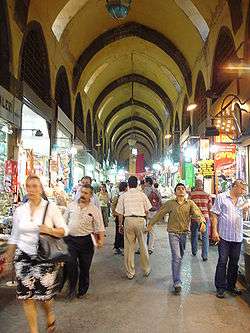Spice Bazaar
The Spice Bazaar (Turkish: Mısır Çarşısı, meaning "Egyptian Bazaar") in Istanbul, Turkey is one of the largest bazaars in the city. Located in the Eminönü quarter of the Fatih district, it is the most famous covered shopping complex after the Grand Bazaar.

History
There are several documents suggesting that the name of the bazaar was first "New Bazaar". The and got its name "Egyptian Bazaar" (Turkish: Mısır Çarşısı) because it was built with the revenues from the Ottoman eyalet of Egypt in 1660.[1] The word mısır has a double meaning in Turkish: "Egypt" and "maize". This is why sometimes the name is wrongly translated as "Corn Bazaar". The bazaar was (and still is) the center for spice trade in Istanbul, but in recent years shops of other types are gradually replacing the sellers of spices.[1]
The building itself is part of the külliye (complex) of the New Mosque. The revenues obtained from the rented shops inside the bazaar building were used for the upkeeping of the mosque.
The structure was designed by the court architect Koca Kasım Ağa, but the construction works began under the supervision of another court architect, Mustafa Ağa, in the last months of 1660; following Istanbul's Great Fire of 1660 that began on 24 July 1660 and, lasting for slightly more than two days (circa 49 hours, according to the chronicles of Abdi Pasha), destroyed many neighbourhoods in the city.[2][3][4] A major rebuilding and redevelopment effort started in the city following the fire, which included the resumption of the New Mosque's construction works in 1660 (halted between 1603 and 1660, the construction of the mosque was ultimately completed between 1660 and 1665) and the beginning of the Spice Bazaar's construction in the same year (all buildings in the New Mosque külliye, including the Spice Bazaar, were commissioned by Sultana Turhan Hatice, the Valide Sultan (Queen Mother) of Sultan Mehmed IV.)[2][4]
Egyptian Bazaar today

Spice Bazaar has a total of 85 shops selling spices, Turkish delight and other sweets, jewellery, souvenirs, and dried fruits and nuts.
Gallery
- Spice Bazaar building
- Interior of the Spice Bazaar
 Main street of the bazaar
Main street of the bazaar- Spices on sale
 Dried fruits in the Spice Bazaar
Dried fruits in the Spice Bazaar- Inside the Bazaar
See also
- Bazaari
- List of streets, hans and gates in Grand Bazaar, Istanbul
- List of shopping malls in Istanbul
- Tabriz Bazaar, the largest covered bazaar in the world.
References
- John Freely: "The Companion Guide to Istanbul" (2000)
- Baer, Marc David (May 2004). "The Great Fire of 1660 and the Islamization of Christian and Jewish Space in Istanbul". International Journal of Middle East Studies. 36 (2): 159–181. doi:10.1017/S002074380436201X. JSTOR 3880030.
- Istanbul Fire Brigade: A chronological list of major fires in the history of Istanbul
- Walkingistanbul.com: Fountain of Sultana Turhan Hatice
Sources
- Freely, John (2000). Blue Guide Istanbul. W. W. Norton & Company. ISBN 978-0-393-32014-5. External link in
|title=(help)
External links
| Wikimedia Commons has media related to Spice Bazaar, Istanbul. |
- Egyptian Bazaar Photos with information
- Buying Spices in Istanbul's Egyptian Bazaar - illustrated article in English
- Points From Turkey, Istanbul - Egyptian Spice Bazaar